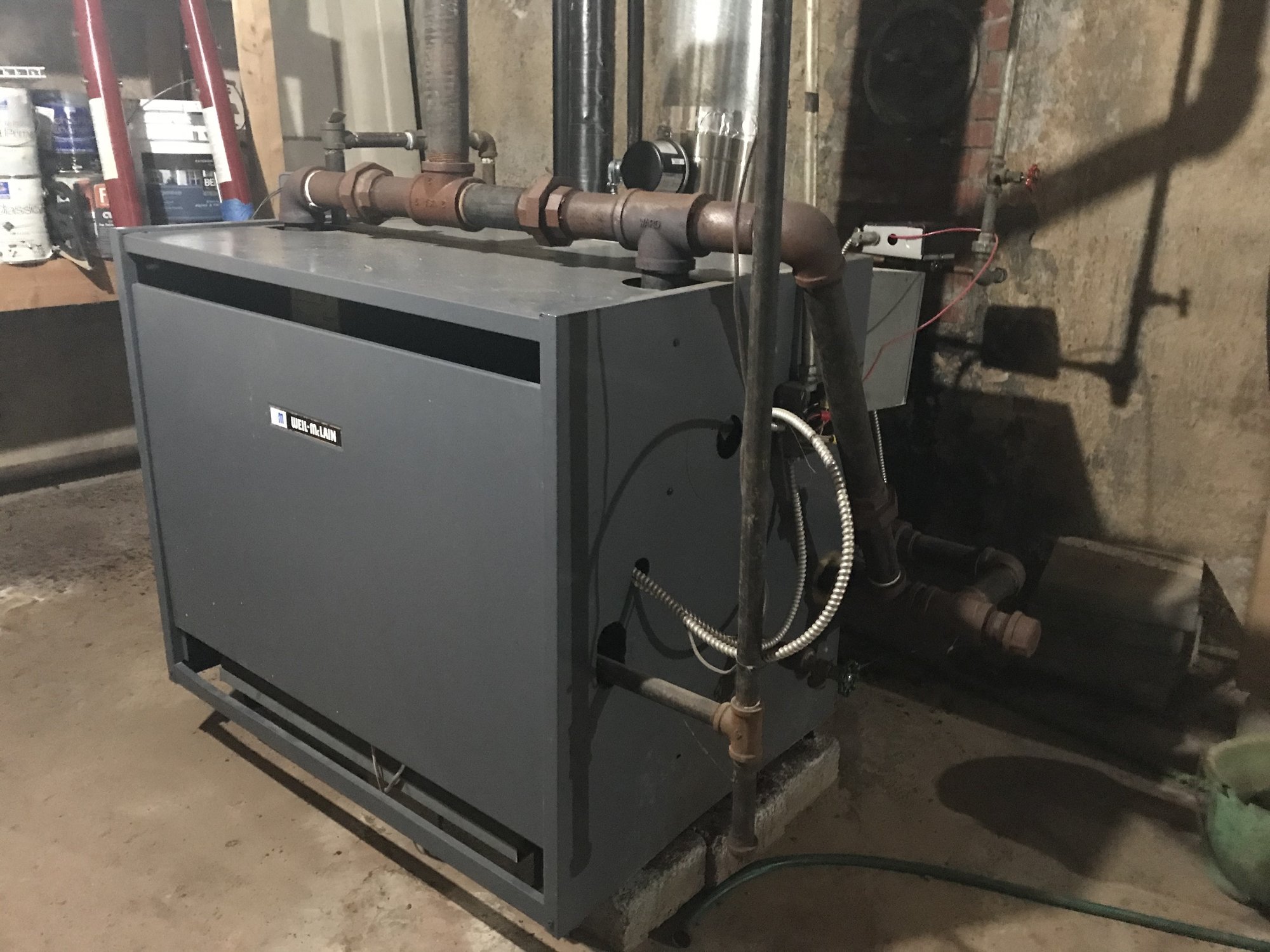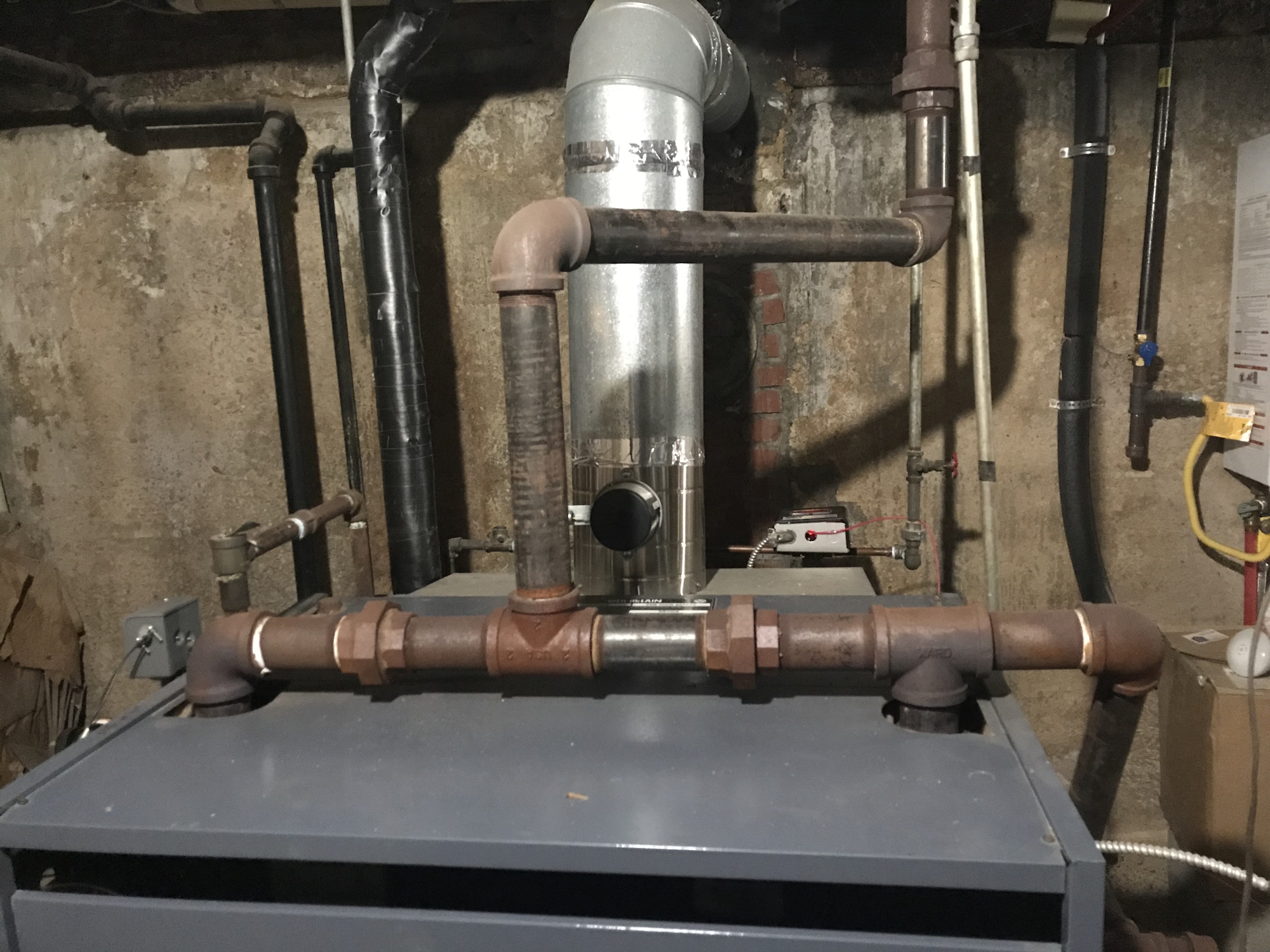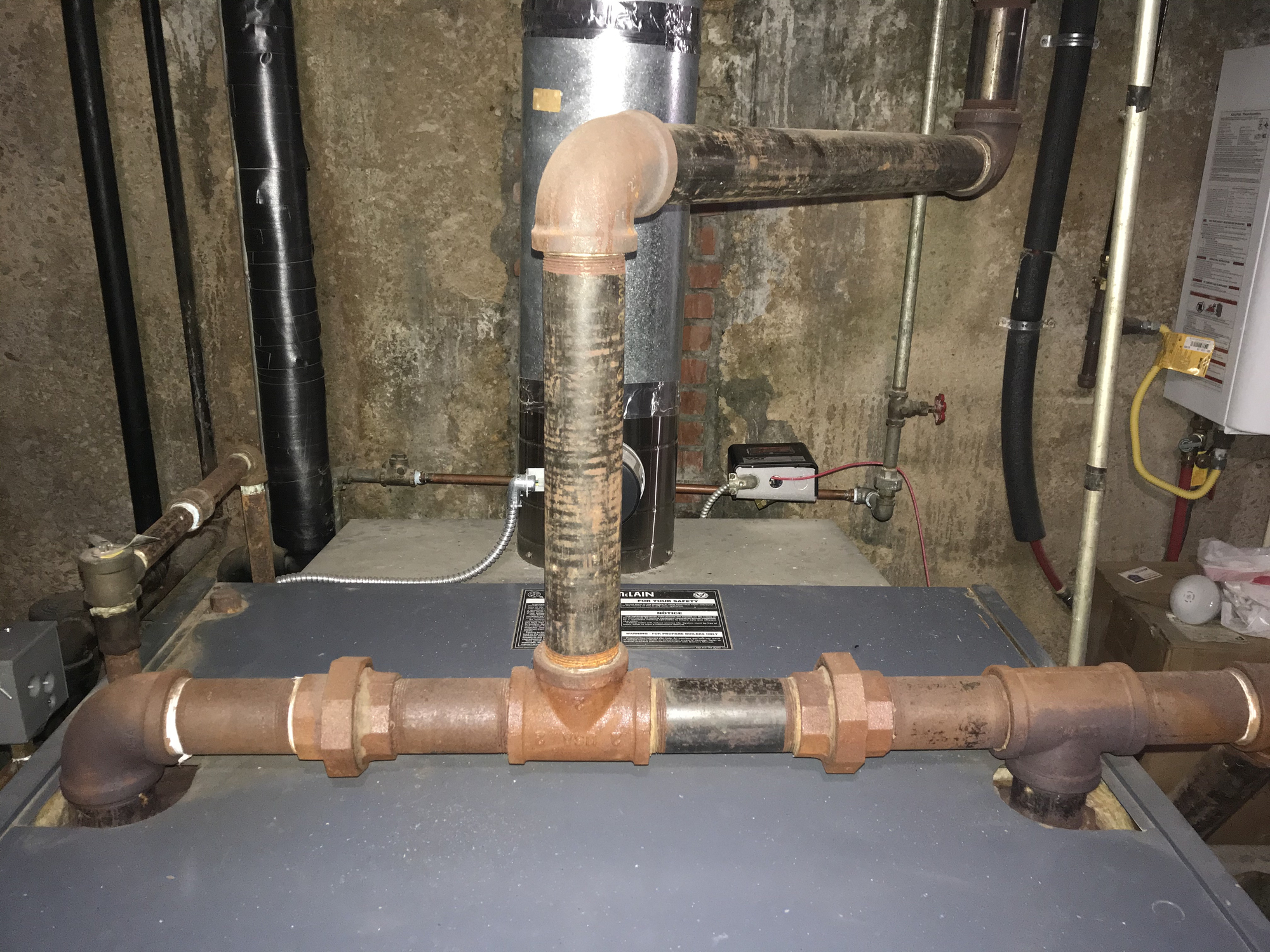Near Boiler Plumbing Fix
https://forum.heatinghelp.com/discussion/182981/2-pipe-return-system#latest
The consensus was that the near boiler plumbing is a disaster, but there is not much boiler expertise within 200 miles of us. I found a plumber that recently moved south from Chicago who has boiler experience, but is definitely not a steam expert. He is small enough to fit in our crawlspace and will be replacing a 20' section of one of the mains that has three leaks. He noticed some pitch issues in the mains that he will address and will also flush out the wet returns at the end of the mains that I suspect are pretty clogged. I can drain the wet lines out of the mud leg, but it flows pretty slowly....
Here is rough diagram of our two main system. One question about pitch...I assume this is parallel flow system based on everything I've read and that all of the mains should be pitched so the high point is near at the boiler....is this correct?

Also have a question about the final leg of the mains

Is there a good reason for this plumbing....seems like you could just pitch downward from a 90° elbow and have a couple more inches of drop on the pipes heading toward the wet returns.
The plumber noticed the issue with the "header" and said that he would also be willing to quote us on redoing the near boiler plumbing, but I do not trust him to know how to do this right. I would appreciate some expert help in designing an efficient near boiler set up. I think if I can give him some plans he can give me a quote on doing the job.
Here is the current "header"



Based on the Weil McLain manual, I sketched out an idea for extending the risers and adding a 3" header. Seems like it a system with two mains that it is best for each to have a separate take-off.

This drawing is not to any sort of scale, but wanted to get thoughts on how to improve the design...and hopefully minimize the amount of re-plumbing of the mains. Mostly wondering if there is a problem with the 90° elbow on the header before the take-offs to the mains....also wondering if the second (rear) take-off can drop straight to the equalizer or if these should be offset. I have seen sketches like this, but not sure if this is optimal

Hope this is somewhat clear.....I am new to steam and have a lot of naive questions and ideas.
Thanks!
Comments
-
Forgot to include the Weil McLain plumbing diagrams for the EGH-85


0 -
Your sketch for the header will certainly be better than what you have now! And shouldn't be that hard to do. The change I would make to it, though, is to take that second main which you now show going up from one leg of a T, with the other leg going down, and move it back towards the other main takeoff and go straight up like it does, then go on over with the header to an elbow going down to the equalizer.
The mains and returns... it's all about pitch. So long as water in the mains and returns can get to where it can drain back to the boiler, there are any number of ways to assemble the fittings!Br. Jamie, osb
Building superintendent/caretaker, 7200 sq. ft. historic house museum with dependencies in New England0 -
That looks like a big boiler for the number of radiators you have. Did you determine the total EDR?Just another DIYer | King of Prussia, PA
1983(?) Peerless G-561-W-S | 3" drop header, CG400-1090, VXT-240 -
The system was inherited from the previous owner....based on the disastrous plumbing I doubt the installer even knew how to calculate EDR for the system.Hap_Hazzard said:That looks like a big boiler for the number of radiators you have. Did you determine the total EDR?
The boiler is only 15 years old and would like to get a few more years out of it...0 -
I think I know what you are recommending....so the two mains will exit the header closer to each other and the header would end with a 90° elbow going down to the equalizer?Jamie Hall said:Your sketch for the header will certainly be better than what you have now! And shouldn't be that hard to do. The change I would make to it, though, is to take that second main which you now show going up from one leg of a T, with the other leg going down, and move it back towards the other main takeoff and go straight up like it does, then go on over with the header to an elbow going down to the equalizer.
Thanks!0 -
Exactly. The header's job is to separate steam from water. So you want the steam to be able to rise up with any water continuing to flow toward the downturned exit elbow. The diagrams in the installation manuals show this usually with options for either 1 or 2 steam risers (depending on the size of the boiler)HansL said:
I think I know what you are recommending....so the two mains will exit the header closer to each other and the header would end with a 90° elbow going down to the equalizer?Jamie Hall said:Your sketch for the header will certainly be better than what you have now! And shouldn't be that hard to do. The change I would make to it, though, is to take that second main which you now show going up from one leg of a T, with the other leg going down, and move it back towards the other main takeoff and go straight up like it does, then go on over with the header to an elbow going down to the equalizer.
Thanks!NJ Steam Homeowner.
Free NJ and remote steam advice: https://heatinghelp.com/find-a-contractor/detail/new-jersey-steam-help/
See my sight glass boiler videos: https://bit.ly/3sZW1el0 -
My manual doesn't have a diagram for two mains, so thanks for the recommendationethicalpaul said:HansL said:Jamie Hall said:
Exactly. The header's job is to separate steam from water. So you want the steam to be able to rise up with any water continuing to flow toward the downturned exit elbow. The diagrams in the installation manuals show this usually with options for either 1 or 2 steam risers (depending on the size of the boiler)0 -
sounds good....no cons? Any special concerns to pass along to a plumber who undoubtedly has never build a drop header?HansL said:
With a drop header does the header still need to be at least 24" above the waterline or do the vertical risers need to extend at least 24" above waterline? Thanks...0 -
-
How much should the header be pitched toward the equalizer end?ethicalpaul said:Exactly. The header's job is to separate steam from water. So you want the steam to be able to rise up with any water continuing to flow toward the downturned exit elbow. The diagrams in the installation manuals show this usually with options for either 1 or 2 steam risers (depending on the size of the boiler)
0 -
1/4” per ft!HansL said:
How much should the header be pitched toward the equalizer end?ethicalpaul said:Exactly. The header's job is to separate steam from water. So you want the steam to be able to rise up with any water continuing to flow toward the downturned exit elbow. The diagrams in the installation manuals show this usually with options for either 1 or 2 steam risers (depending on the size of the boiler)0 -
A drop header also gives you swing joints so the Tees don't have to have the same spacing between them that the risers have. That means less stress on the block from thermal expansion and easier assembly.
There are no cons to a drop header other than the cost of a couple more Ells and nipples.Bob Boan
You can choose to do what you want, but you cannot choose the consequences.0 -
Thanks! I also noticed that the drop header pic from pecmsg and others that I have seen online have a union in between the risers Ts....is that also a thermal expansion issue? Wondering if I should have the plumber use a long section of 3' pipe for the header or two shorter pieces with a union?Ironman said:A drop header also gives you swing joints so the Tees don't have to have the same spacing between them that the risers have. That means less stress on the block from thermal expansion and easier assembly.
There are no cons to a drop header other than the cost of a couple more Ells and nipples.
Also wondering if I go with a drop header if it would be better to use 2" risers as indicated in the Weil McLain (minimal recommendation) manual or 3" risers? I assume bigger is better from both a stability and steam perspective....
0 -
-
The system doesn’t currently have a king valve, but wonder if this would be good to add during this job? Would each main need a king valve or is there some other way to plumb the system with one king to allow pressure build up for a blow down?
0 -
You also need to add valves to the return for the king valve to do its job.
The boiler could possibly be downfired to better match the connected radiation if weil mcclain allows it but I would fix the near boiler piping first and see how that works before trying to downfire it.
Add a skim port with a ball valve if there isn't already one.0 -
King valves are on of those nice to have but almost never used gadgets, at least in my humble opinion. You don't need any pressure to flush out a boiler, nor for flushing float type LWCOs. The only time I use the ones on the systems I care for is when I have some reason to suspect the high level pressuretrols aren't working (they always are...).Br. Jamie, osb
Building superintendent/caretaker, 7200 sq. ft. historic house museum with dependencies in New England1 -
Thanks for your comments. There is already a valve at the pumped return, but would need to add one to the loop to the wet/end of main return.mattmia2 said:You also need to add valves to the return for the king valve to do its job.
The boiler could possibly be downfired to better match the connected radiation if weil mcclain allows it but I would fix the near boiler piping first and see how that works before trying to downfire it.
Add a skim port with a ball valve if there isn't already one.
I have been able to get a lot of muck out of the boiler without a building up pressure, so I guess I will just see how much extra cost is associated with adding the valves...
There is not a skim port....will add that to the list!
I'll check back on downfiring the boiler once the plumbing is repaired....
Thanks!0 -
Thanks! We'll let cost be the judge of whether to do this....based on all of your comments, there are plenty of other places to spend the money in our system.Jamie Hall said:King valves are on of those nice to have but almost never used gadgets, at least in my humble opinion. You don't need any pressure to flush out a boiler, nor for flushing float type LWCOs. The only time I use the ones on the systems I care for is when I have some reason to suspect the high level pressuretrols aren't working (they always are...).
I have been able to get good flushes out of the two drains on the EGH-85....was really dirty when we inherited it and now is almost clear!
I would like to put in some way to flush the wet return/end of mains. Right now, there is a spigot at the end of the wet return just before the loop
but nothing anywhere else in the wet line. Was thinking a valve below the waterline where the two mains come together to the single wet return...thoughts?
Thanks!0 -
I use mine for blow-downs and to make sure the pressuretrol is working, because in normal use it never builds enough pressure to shut off.Jamie Hall said:King valves are on of those nice to have but almost never used gadgets, at least in my humble opinion. You don't need any pressure to flush out a boiler, nor for flushing float type LWCOs. The only time I use the ones on the systems I care for is when I have some reason to suspect the high level pressuretrols aren't working (they always are...).
Just another DIYer | King of Prussia, PA
1983(?) Peerless G-561-W-S | 3" drop header, CG400-1090, VXT-240
Categories
- All Categories
- 87.3K THE MAIN WALL
- 3.2K A-C, Heat Pumps & Refrigeration
- 61 Biomass
- 427 Carbon Monoxide Awareness
- 119 Chimneys & Flues
- 2.1K Domestic Hot Water
- 5.8K Gas Heating
- 115 Geothermal
- 165 Indoor-Air Quality
- 3.7K Oil Heating
- 76 Pipe Deterioration
- 1K Plumbing
- 6.5K Radiant Heating
- 395 Solar
- 15.6K Strictly Steam
- 3.4K Thermostats and Controls
- 56 Water Quality
- 51 Industry Classes
- 50 Job Opportunities
- 18 Recall Announcements








